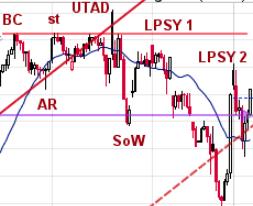Wyckoff at Work in the Intraday Timeframe
Understanding the intraday timeframe in trading is crucial for those looking to capitalize on shorter-term price movements and opportunities within the financial markets. One popular method that traders use to analyze and interpret intraday price action is the Wyckoff method. Developed by Richard D. Wyckoff in the early 20th century, this method focuses on studying the relationship between supply and demand to make informed trading decisions.
Intraday trading refers to the practice of buying and selling financial instruments within the same trading day. This style of trading requires quick decision-making and the ability to interpret price movements in real-time. The Wyckoff method provides traders with a framework to analyze intraday price action and identify potential buying or selling opportunities.
Wyckoff believed that market movements are driven by the imbalances between supply and demand. By carefully analyzing price and volume data, traders using the Wyckoff method can gain insights into the intentions of large market players and anticipate potential price movements. In the intraday timeframe, these principles remain relevant and can help traders navigate the fast-paced nature of short-term trading.
One key concept of the Wyckoff method is the analysis of price trends and the phases of accumulation and distribution. During the accumulation phase, prices consolidate as smart money accumulates positions before a potential uptrend. This phase is characterized by decreasing selling pressure and may present buying opportunities for traders. On the other hand, the distribution phase occurs when prices consolidate before a potential downtrend, with smart money distributing their holdings to unsuspecting participants.
Intraday traders can apply these principles by observing price patterns and volume surges that indicate potential accumulation or distribution phases. By identifying these phases early, traders can position themselves to capitalize on the subsequent price movements. Additionally, the Wyckoff method emphasizes the importance of confirming price action with volume data to validate trading signals and reduce false signals.
Another key component of the Wyckoff method is the analysis of support and resistance levels within the intraday timeframe. Traders can use these levels to identify potential entry and exit points for their trades. By mapping out key support and resistance levels based on price and volume data, traders can establish a trading plan that aligns with the principles of the Wyckoff method.
Overall, the Wyckoff method provides a comprehensive framework for analyzing price action and making informed trading decisions in the intraday timeframe. By understanding the dynamics of supply and demand, along with key price levels and volume patterns, traders can improve their chances of success in the fast-paced world of intraday trading. Embracing the principles of the Wyckoff method can help traders navigate the complexities of short-term price movements and enhance their profitability within the intraday timeframe.



